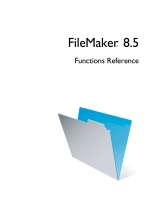
2-2 FileMaker Server Administrator’s Guide
Guests can use the following network protocols to access database
files hosted by FileMaker Server:
Important FileMaker Server uses a proprietary networking scheme
and operates independently of your network operating system (NOS)
access privileges. Multi-user FileMaker Pro databases will be
available to FileMaker Pro guests regardless of NOS privileges. To
restrict access to FileMaker databases, use the access privileges
available in FileMaker Pro 5.x. For more information, see
“Protecting files with a password” on page 6-17. Database files
should be shared using networking available in FileMaker Pro. Do
not share FileMaker Pro files using Windows file sharing.
Installing FileMaker Server
Use the Setup program to install FileMaker Server on your hard disk.
This installation procedure describes how to install the:
1 FileMaker Server application and supporting files
1 FileMaker Server example files
By default, the Setup program creates a folder named Program
Files\FileMaker\FileMaker Server 5.5 folder on your hard disk, then
installs FileMaker Server and example files in it. However, you can
choose a different location during installation.
To install FileMaker Server on your hard disk:
1. Exit all other applications and turn off virus protection utilities.
2. Insert the FileMaker Server CD into your CD or DVD drive.
3. Double-click the Read Me icon to read important information
about this release of FileMaker Server. Then close the Read Me file.
4. Double-click setup.exe.
You see the Welcome screen of the FileMaker Server Setup Wizard.
5. Click Next.
6. Read the license agreement. If you agree to these terms, select I
accept the terms in the License Agreement, then click Next.
7. Personalize this copy of FileMaker Server by typing your name,
organization name, and indicate who can access FileMaker Server
from this computer (only you or anyone who uses the computer).
Then click Next.
8. Choose Complete in the Setup Type screen to install
FileMaker Server and the example files, then click Next.
Note If you don’t have enough disk space on the server computer, you
see the Out of Disk Space dialog box. Quit the installation, remove
files from the installation volume to free some space, and try again.
9. Select an option for FileMaker Server start-up, then click Next.
Network
protocol Windows guest
Mac OS 8.6
to 9.1 guest Mac OS X guest
IPX/SPX NWLink IPX/SPX
Compatible Transport
(Windows NT client)
Microsoft IPX/SPX
Compatible Transport
(Windows 95 or
Windows 98 client)
IPX is not
supported
IPX is not supported
TCP/IP TCP/IP Apple Open
Transport 1.1.1
TCP/IP is integrated
with Mac OS X
Select If you want FileMaker Server to start
Automatic Whenever Windows starts.
Note After installation, you must start the FileMaker Server
service manually the first time. For more information, see “Starting
FileMaker Server (Windows NT)” on page 7-1 or “Starting
FileMaker Server (Windows 2000)” on page 7-1. Thereafter,
FileMaker Server will start when you restart the computer.
Manual After you turn on the FileMaker Server service in the Services
control panel (Windows NT) or Services console (Windows
2000). For more information, see “Starting FileMaker Server
(Windows NT)” on page 7-1 or “Starting FileMaker Server
(Windows 2000)” on page 7-1.
























